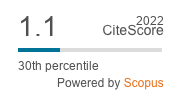El estudio de la Isla de Calor Urbana de Superficie del Área Metropolitana de Santiago de Chile con imágenes Terra-MODIS y Análisis de Componentes Principales
DOI:
https://doi.org/10.4067/S0718-34022014000100009Keywords:
Principal Component Analysis, surface urban heat island, urban heat sink, Terra MODISAbstract
In order to understand the patterns and intensities of the Surface Urban Heat Islands (SUHIs) of Santiago emission temperatures were calculated using 53 Terra MODIS satellite images and then factor reduction was performed using Principal Components Analysis (PCA). In addition, intensity maps of SUHIs were created. Results show that the maximum temperature (with intensities measuring above 5°C) within the SUHI tends to be located in the central municipalities of Santiago, as well as in the municipalities of Huechuraba and Quilicura. Furthermore, PCA reveals four typical patterns, which explain 90.6% of cases: consolidated SUHI, piedmont SUHI and high income wedge, no SUHI and high intensity SUHI in the south. It has been hypothesized that the lack of a SUHI to the drain effect, which is linked to the katabatic breeze, causing the SUHI to move toward the west sector of the city






